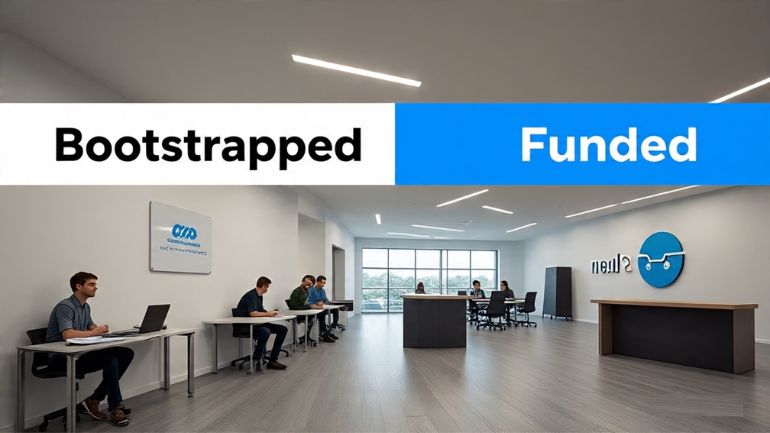Building a SaaS company comes with enough questions—your pricing model, your tech stack, your go-to-market strategy. But one of the most critical decisions founders face is how to finance growth.
Do you bootstrap and retain control, even if that means slower scaling? Or raise funding, accelerate growth, and give up equity for capital?
There’s no universal right answer. But there is a right answer for your goals, your risk tolerance, and the business you’re building.
The Bootstrapped Path: Control, Constraints, and Creativity
Founders who bootstrap typically fund the company through savings, revenue, or side gigs—opting out of the investor route entirely. There’s a certain romanticism to it, but also real-world challenges that require discipline and trade-offs.
Pros:
- Full ownership and control over decisions
- No investor pressure to hit aggressive growth targets
- Freedom to build on your own timeline and values
Cons:
- Slower growth due to limited capital
- More personal financial risk
- Harder to hire, market, or scale without early traction
Bootstrapped SaaS founders often get scrappy with their growth strategies—relying heavily on organic channels, referrals, or partner-led growth. They also tend to focus obsessively on profitability from the outset, which can build healthy financial habits early on.
That said, scaling without outside funding requires incredible focus. You may have to say no to opportunities you simply can’t afford to pursue yet, whether it’s a rebrand, a product pivot, or a new market entry.
The Funded Path: Speed, Scale, and Stakeholder Expectations
Venture funding opens up another world entirely. With capital comes acceleration—hiring faster, spending more on marketing, and going after a larger share of the market in less time. But it also comes with expectations.
Pros:
- Resources to grow quickly and outpace competitors
- Ability to invest in top-tier talent, tools, and tech
- Mentorship and access to networks via investors
Cons:
- Loss of equity and, often, some control
- Pressure to grow fast—sometimes at the expense of sustainability
- Risk of building toward investor milestones rather than customer needs
Not all funding is equal, of course. There’s a spectrum—from angel investors to VCs to growth equity. The key is knowing why you’re raising and what success looks like for both you and your investors.
If you’re building a category leader or targeting enterprise markets, funding can help you gain traction before others catch up. But if your goal is long-term cash flow and ownership, venture capital might not align with that picture.
Questions to Ask Yourself Before Choosing a Path
Whether you’re standing at the fork in the road or already a few steps down one side, these questions can help clarify your thinking:
- What’s your personal risk tolerance? Can you go without income while building, or would external capital provide the stability to focus?
- How fast do you want—or need—to grow? Are you in a race, or building something more sustainable over time?
- Do you want to own 100% of a smaller pie, or a slice of a bigger one?
- How big is your market? Some markets simply require more capital to win.
- Would funding accelerate your roadmap meaningfully, or just make things “more comfortable”?
There’s no shame in either route. The key is being honest about what you’re trying to build—and who you’re building it for.
Hybrid Paths and Gray Areas
It’s worth noting that the binary of “bootstrapped vs. funded” is often oversimplified. Many companies start bootstrapped and raise funding later, once they’ve found product-market fit. Others take on non-dilutive capital (like revenue-based financing or loans) to bridge the gap.
Some founders work with agencies or consultants to drive revenue-first strategies before raising capital, allowing them to negotiate from a stronger position. In fact, partnering with a B2B SaaS growth agency can be a smart move for bootstrapped teams that want expert-level execution without committing to full-time hires.
There’s flexibility in how you grow. And flexibility, ironically, can be a competitive edge in SaaS.
Aligning Financing With Your Long-Term Vision
The most important consideration isn’t the amount of money in your bank account—it’s alignment. Is your financing strategy aligned with the kind of company you want to build, the life you want to lead, and the customers you want to serve?
Bootstrapping gives you freedom, but demands patience. Funding gives you fuel, but comes with strings. And both can be the right choice, depending on your goals.
Just don’t choose one out of fear, ego, or trend-following. Choose the path that lets you build your version of success.
Because at the end of the day, the best SaaS companies don’t just scale fast—they scale well. On their terms. With their vision intact.


Be the first to comment on "Bootstrapped vs. Funded SaaS: Which Route Aligns With Your Long-Term Goals?"